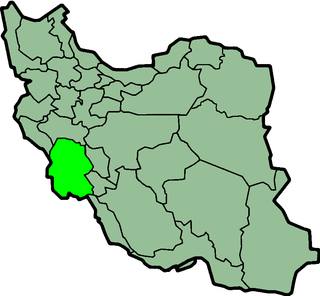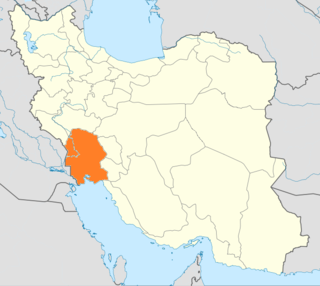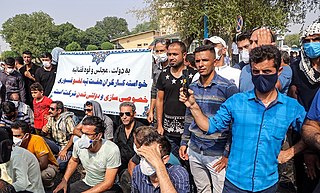Related Research Articles

Khuzestan province is one of the 31 provinces of Iran. It is in the southwest of the country, bordering Iraq and the Persian Gulf. Its capital is Ahvaz and it covers an area of 63,238 square kilometres (24,416 sq mi). Since 2014, it has been part of Iran's Region 4.

Ahvaz is a city in the Central District of Ahvaz County, Khuzestan province, Iran, and serves as capital of the county, the district, and the province. It is home to Persians, Arabs, Bakhtiaris, Dezfulis, Shushtaris, and others. Languages spoken in the area include Persian and Arabic, as well as Luri (Bakhtiari) and different persian dialects such as Dezfuli, Shushtari and etc. Ahvaz's population is about 1,300,000 and its built-up area with the nearby town of Sheybani is home to 1,136,989 inhabitants.

Khuzestan province is a petroleum-rich, ethnically-diverse province in southwestern Iran. Oil fields in the province include Ahvaz Field, Marun, Aghajari, Karanj, Shadegan and Mansouri. Amnesty International has voiced human-rights concerns about Khuzestan's Arab population, and United Nations special rapporteur Miloon Kothari has also drawn attention to Arab displacement and poverty among the Laks.
The Ahvaz bombings was a series of bomb explosions, that took place mostly in Ahvaz, Iran in 2005 and 2006, and were blamed on Ahvaz separatist organizations of Arabs. The bombings were linked to the violent '15 April unrest' in Ahvaz, prior to the bombings. Some 28 people were killed and 225 wounded in Ahvaz bombings.

The Arab Struggle Movement for the Liberation of Ahwaz is an Arab nationalist and separatist insurgent group which advocates the secession of an area in southern Iran including all of Khuzestan Province and Bushehr Province and parts of Ilam Province, Hormozgan Province, Chaharmahal and Bakhtiari Province and Kohgiluyeh and Boyer-Ahmad Province from Iran and the establishment of an Arab state, a goal which it is attempting to achieve by waging a direct and violent conflict against Iran. The claimed area is shown in the group’s logo as well.
The 2011–2012 protests in Iran were a series of demonstrations in Iran which began on 14 February 2011, called "The Day of Rage". The protests followed the 2009–2010 Iranian election protests and were influenced by other concurrent protests in the region.
The following is a timeline of the Syrian Civil War from May to August 2011, including the escalation of violence in many Syrian cities.

2005 Ahvaz unrest or 15 April Ahvaz Protests were violent riots, initiated by Iranian Arabs in the city of Ahvaz in southwestern Iranian province of Khuzestan. The unrest erupted on 15 April 2005, and lasted for 4 days. Initially, the Iranian Interior Ministry stated that only one person had been killed, however an official at a hospital in Ahvaz said that there were between 15 and 20 mortal casualties. Government officials blamed the unrest on Britain, whose troops based just across the border in southern Iraq. Following the unrest, several bombings were carried out in Ahvaz, killing 28 people. In 2006, Iran executed five Arab separatists, convicted of carrying out the bombings in 2005.
The following is a timeline of the Syrian uprising from September to December 2011. This period saw the uprising take on many of the characteristics of a civil war, according to several outside observers, including the United Nations Commission on Human Rights, as armed elements became better organized and began carrying out successful attacks in retaliation for the ongoing crackdown by the Syrian government on demonstrators and defectors.

The 1979 Khuzestan uprising was one of the nationwide uprisings in Iran, which erupted in the aftermath of the Iranian Revolution. The unrest was fed by Arab demands for autonomy. The uprising was effectively quelled by Iranian security forces, resulting in more than a hundred people on both sides killed.
The following is a timeline of the Syrian Civil War from January to April 2012, during which time the spate of protests that began in January 2011 lasted into another calendar year. An Arab League monitoring mission ended in failure as Syrian troops and anti-government militants continued to do battle across the country and the Syrian government prevented foreign observers from touring active battlefields, including besieged opposition strongholds. A United Nations-backed ceasefire brokered by special envoy Kofi Annan met a similar fate, with unarmed UN peacekeepers' movements tightly controlled by the government and fighting.
The Arab Spring unrests and revolutions unfolded in Tunisia, Egypt, Libya, Yemen, Syria and Bahrain, and in the rest of the region, some becoming violent, some facing strong suppression efforts, and some resulting in political changes.

Arab separatism in Khuzestan refers to the century-long separatist Arab movement in the western part of the Khuzestan Province in Iran.
Hashem Shabani, also known as Hashem Shabaninejad, was an ethnic Ahwazi Arab citizen of the Islamic Republic of Iran. He was a high school teacher of Arabic language and literature, a poet in both Arabic and Persian, and an activist who promoted Arabic culture and literature in Iran. In February 2011, government authorities arrested Shabani and four other Ahwazis.
Khuzestani Arabs are the Arab inhabitants of the Khuzestan province and the largest Arab community in Iran which primarily reside in the western half of Khuzestan. This area is known as Ahwaz by the Arab community, and the capital of Khuzestan is Ahvaz. As of 2010, Khuzestani Arabs numbered around 1.6 million people.
Islamic Reconciliation Party or Al-Wefaq Islamic Party formerly named Reconciliation Committee, was an Iranian local ethnic party associated with Arab minority in Khuzestan Province.

Public protests took place in several cities in Iran beginning on 28 December 2017 and continued into early 2018. The first protest took place in Mashhad, Iran's second-largest city by population, initially focused on the economic policies of the country's government; as protests spread throughout the country, their scope expanded to include political opposition to the theocratic regime of Iran and its longtime Supreme Leader, Ali Khamenei. The Iranian public showcased their fury in the protests with a wide repertoire of chants aimed at the regime and its leadership. According to The Washington Post, protesters' chants and attacks on government buildings upended a system that had little tolerance for dissent, with some demonstrators even shouting "Death to the dictator!"—referring to Supreme Leader Ayatollah Ali Khamenei—and asking security forces to join them.
The 2018 Iranian water protests were a series of protests in Iran involving demands for improvements in the provision of freshwater. The protests erupted after a period of severe drought in the country. Participants accused the Iranian authorities of water mismanagement, worsening the impact of the drought. The protests coincided with a series of larger protests and civil unrest in Iran.

The 2017–2021 Iranian protests sparked by the 2016 Cyrus the Great revolt led to a series of political movements civil disobedience, online activism, and demonstrations followed by government crackdowns that since the mid-2010s have erupted nationwide in Iran, increasingly calling for regime change and overthrow of the Shiite political Islam and theocracy of the Islamic Republic of Iran, which began in 1979 following the Iranian Revolution.
The 2021 Iranian water protests were a series of protests by Iranians against water shortages in Khuzestan province during the summer. Protests broke out on 15 July 2021 due to the ongoing water crisis in Iran but spread across the country to other provinces and cities where people organised rallies in solidarity with Khuzestan, including Tehran, Kermanshah, Isfahan, Bushehr, Lorestan, Kurdistan, East Azerbaijan, North Khorasan and Alborz. Protests were soon dubbed 'The Uprising of the Thirsty" and turned violent as police forces attempted to suppress them due to demands for the end of the current regime. Casualties were recorded both amongst police forces and civilian demonstrators. Protests in Khuzestan lasted for around 10 days and were predominantly urban. The last large-scale demonstration in solidarity with Khuzestan took place on 31 July in Tehran. The violent nature of the protests received a lot media-attention and various government officials made statements promising extended and specific support to the region. This included releasing more water from Karkheh Dam in northern Khuzestan and sending emergency water tanks to most affected regions.
References
- ↑ Elfatih Abdelsalam (June 2015). "The Arab spring: Its origins, evolution and consequences… four years on" – via ResearchGate.
- 1 2 3 Ammar Benaziz and Abeer Tayel (18 April 2011). "Fifteen dead in Iran's Ahwaz". Al Arabiya . Retrieved 2 March 2012.
- 1 2 3 4 "European Parliament condemns Iran's violation of minorities' rights". 15 June 2012.
- ↑ "Iran Arab prisoners at risk of execution, Amnesty warns". The Guardian. London. 13 June 2012.
- ↑ "BBC NEWS | in Depth | Iranian embassy siege | Six days of fear".
- ↑ "BBC NEWS | in Depth | Iranian embassy siege | Iran and the hostage-takers".
- ↑ Mustapha Ajbaili (16 April 2011). "One dead in Ahwaz clash". Al Arabiya . Archived from the original on 9 November 2013. Retrieved 2 March 2012.
- 1 2 Staff writer (29 April 2011). "Iran: Calls To Investigate Reported Killings of Demonstrators". Eurasia Review . Retrieved 2 March 2012.
- ↑ Roula Hajjar (30 April 2011). "IRAN: Outside the spotlight, Arab uprising smolders in country's southwest". Los Angeles Times . Retrieved 3 June 2011.
- 1 2 3 4 "Iran: Arrest Sweeps Target Arab Minority". UNHCR. 7 February 2012. Archived from the original on 20 November 2012. Retrieved 2 March 2012.
- ↑ "Iran: Investigate Reported Killings of Demonstrators". Human Rights Watch. 29 April 2011. Retrieved 3 June 2011.
- ↑ "Iran Arab minority protest deaths must be investigated". Amnesty International. 19 April 2011. Retrieved 2 March 2012.
- ↑ Esfandiari, Golnaz (19 April 2011). "Iran's Nobel Laureate Ebadi Warns of Unrest Among Ethnic Arabs in Iran". Radio Free Europe/Radio Liberty . Retrieved 3 June 2011.
- 1 2 Saeed Kamali Dehghan (18 April 2011). "Iranian Sunni protesters killed in clashes with security forces". The Guardian . London. Retrieved 3 June 2011.